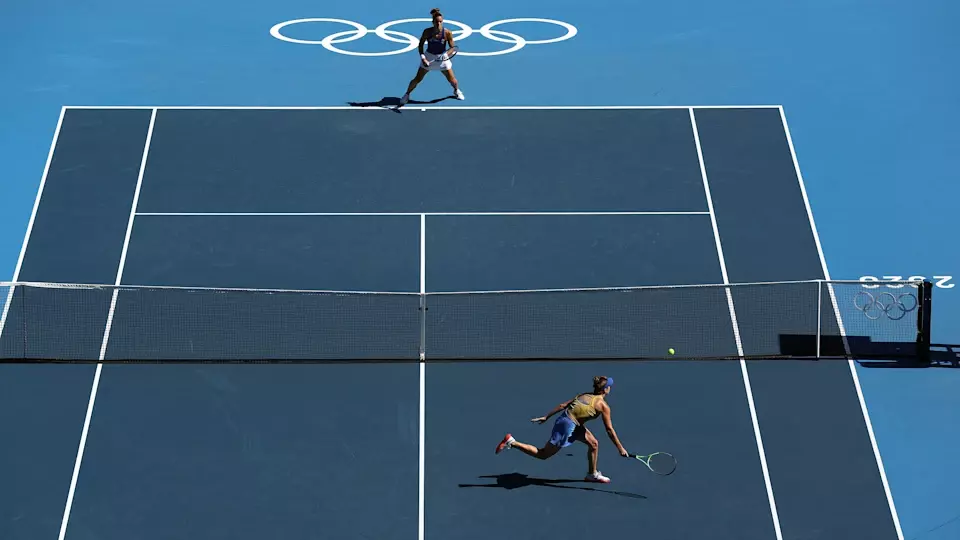Introduction: Tennis Rules
Tennis Rules: Tennis is a captivating sport that combines skill, strategy, and athleticism. Whether you’re a seasoned player or a spectator, understanding the rules of tennis is essential for a fulfilling experience. In this article, we will delve into the intricacies of tennis rules to demystify the game and enhance your appreciation for this thrilling sport.

Scoring System
Tennis has a unique scoring system, with matches played in sets. A match typically consists of best-of-three sets for women and best-of-five sets for men. Each set is divided into games, and games into points. The scoring sequence is 15, 30, 40, and game. If both players or teams reach 40-40, it’s called a deuce, and they must win two consecutive points to secure the game.
Serving Rules
Players take turns serving, with one serving for an entire game before alternating. The server must stand behind the baseline, between the center mark and the sideline, and serve diagonally to the opponent’s service box. Failure to land the ball in the service box results in a fault and two consecutive faults lead to a double fault, resulting in the loss of a point.
In-Play Rules
The point begins with a serve and continues until one player commits a fault. The ball must land within the boundaries of the court, and players must alternate hitting the ball over the net. The ball can bounce once in the opponent’s court, and players must avoid touching the net during play. If a player hits the ball outside the court boundaries, their opponent scores a point.
Tiebreak Tennis Rules
In tennis, if a set reaches a 6-6 tie, a tiebreak is played to determine the set winner. The player or team who scores seven points first, with a lead of at least two points, wins the tiebreak and the set.
Changeover and Rest Rules
Players change ends of the court after every odd-numbered game in a set. Additionally, there is a 90-second changeover between sets and a brief 120-second rest after the third and fifth sets in men’s matches.
Let Ruled
If the serve hits the net but lands in the service box, it is called a “let,” and the server gets another opportunity to serve without penalty. Let serves not count as faults.
Hindrance and Code Violations
Players must avoid hindrance, which includes any action that hinders the opponent’s ability to play the point. Code violations, such as racket abuse or unsportsmanlike conduct, may result in warnings, point penalties, or even disqualification.
Conclusion: Tennis Rules
Understanding tennis rules adds depth to the enjoyment of this dynamic sport. Whether you’re a casual viewer or an aspiring player, familiarity with the rules enhances your appreciation for the skill and strategy required to excel in the game. So, the next time you watch a thrilling tennis match, you’ll have a solid grasp of the rules governing the action on the court.
Frequently Asked Questions (FAQs) about Tennis Rules
What is the scoring system in tennis?
In tennis, the scoring system consists of points, games, and sets. The sequence is 15, 30, 40, and game. Deuce occurs when both players reach 40-40, and a player must win two consecutive points to secure the game.
How does the serving rotation work in tennis?
Players take turns serving, with one player serving for an entire game before alternating. The server must stand behind the baseline, between the center mark and the sideline, and serve diagonally to the opponent’s service box.
What happens if a serve is a fault in tennis?
If a service lands outside the service box, it is considered a fault. Two consecutive faults result in a double fault, leading to the loss of a point.
Can a player touch the net during a point in tennis?
No, players must avoid touching the net during play. Touching the net results in the loss of the point.
How does the tiebreak system work in tennis?
In sets that reach a 6-6 tie, a tiebreak is played. The first player or team to reach seven points with at least a two-point advantage wins the tiebreak and the set.
When do players change ends during a tennis match?
Players change ends of the court after every odd-numbered game in a set. Additionally, there is a 90-second changeover between sets.
What is a “let” in tennis?
A “let” occurs when the serve hits the net but lands in the service box. In this case, the server gets another opportunity to serve without penalty.
Are there any rules for hindrances in tennis?
Yes, players must avoid hindrance, which includes any action that hinders the opponent’s ability to play the point. This can result in a let or, in more severe cases, a loss of the point.
What are code violations in tennis?
Code violations include actions like racket abuse or unsportsmanlike conduct. Depending on the severity, violations may result in warnings, point penalties, or even disqualification.
Is there a difference in the number of sets played between men’s and women’s tennis matches?
Yes, women’s matches are typically best-of-three sets, while men’s matches are best-of-five sets.
follow seekertimes.com and tennis.seekertimes.com
